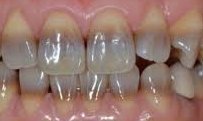Tooth development and staining:
At birth the adult teeth are already beginning to grow unseen deep inside the bones of the mouth. Even before these new adult teeth become visible, they will take on permanent stains due to over-use of certain medications or extreme doses of fluoride in young children. The staining will be noticed as soon as these adult teeth grow in.
Here’s a guide to when the baby teeth and adult teeth grow in:
The baby teeth:
At 8 months of age, or even a bit earlier, the lower front baby teeth will first appear. The baby teeth will continue to grow in (from front to back) until the age of about two and a half years at which time all of the baby teeth are fully grown in - all 20 of them.
The adult teeth:
The first adult teeth to appear are the molars in the back of the mouth. They begin to grow in at six years. This adult molar grows in behind the last baby tooth and often grows in unnoticed although some children will experience discomfort there. The adult teeth then continue to grow in from front to back just like the baby teeth did until the last adult tooth comes in at age 12. The wisdom teeth (also called third molars) are very variable and appear at many different ages.
Tetracycline stains. These stains are permanent and often require porcelain crowns or laminates to correct.
The Causes of Tooth Staining
Permanent staining of adult teeth begins at birth when the adult teeth begin to form deep in the bone of the mouth.Certain antibiotics, and excess use of fluoride, is the main cause of adult tooth staining. At the time the adult teeth grow in (between six and 12 years of age), the stains become visible to the eye.
About permanent versus surface stains:
Permanent stains cannot be easily cleaned off. These stains are locked inside the teeth and are difficult to reach. On the other hand, surface stains can be scrubbed off with a ‘whitening toothpaste’. These toothpastes contain hydrogen peroxide for chemical dissolving of stains and abrasives for scrubbing. Whitening toothpastes have little or no effect on permanent stains deep within the tooth. Always remember that for the most thorough removal of surface stains, seek a professional dental cleaning.
Permanent stains are caused by antibiotics given to children while the adult teeth are forming in the bone from birth until about 11-12 years when the back molars are completely grown in. These staining antibiotics include tetracycline, doxycycline, and minocycline (often used in the treatment of acne). Permanent stains also result from excess fluoride given to young children. Your dentist will advise you on the proper levels of fluoride to be used in your area.
More about minocycline and tooth, skin, and bone staining: Minocycline hydrochloride, is an antibiotic related to tetracycline. This antibiotic can be particularly problematic. It has been shown to cause pigmentation in a variety of tissues including skin, nails, sclera (eyes), conjunctiva (around the eyes), and teeth. Adult tooth discoloration is a common side effect following long-term ingestion of minocycline. Another side-effect of minocycline on the oral cavity is the rare occurrence of "black bone disease" which is usually discovered during dental surgery when discoloration of the bones of the mouth are found.
Surface stains result from amoxicillin (which also is a culprit in permanent staining), chlorhexidine (given by prescription and used to treat gum inflammation). Many blood pressure (BP) medications, and some antihistamines also cause surface staining. The reason for surface staining from BP medications and antihistamines may be the result of reduced saliva flow which allows bacterial growth and the depositing of proteins on the surface of teeth. Note that reduced saliva flow in the elderly is also a source of surface stains in teeth.




